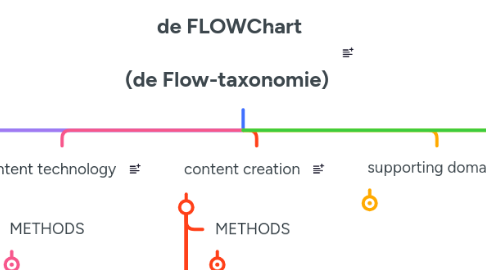
1. content strategy
1.1. METHODS
1.1.1. 1. initiation
1.1.2. 2. analysis
1.1.2.1. user interviews
1.1.2.2. inventory
1.1.3. 3. strategy
1.1.4. 4. change
1.1.5. 5. care
1.2. STANDARDS
1.3. DELIVERABLES
1.3.1. audit report
1.3.2. content analysis
1.3.3. content strategy document
1.3.4. taxonomy
1.3.5. action plan
1.4. SERVICES
1.4.1. consultancy
1.4.2. workshops
1.5. TOOLS
1.5.1. inventory tool
1.5.2. questionnaire tool
1.5.3. taxonomy designer
2. content management
2.1. METHODS
2.1.1. document management (DM)
2.1.2. web content management (WCM)
2.1.3. wiki management
2.1.4. component content management (CCM)
2.1.5. learning content management (LCM)
2.2. STANDARDS
2.2.1. DITA
2.2.2. DocBook
2.2.3. S1000D
2.2.4. SCORM
2.3. DELIVERABLES
2.3.1. applied content model
2.3.2. training
2.3.3. information architecture
2.3.4. metadata
2.3.5. governance
2.3.6. workflows
2.3.7. translation management
2.4. SERVICES
2.4.1. consultancy
2.4.2. training & coaching
2.5. TOOLS
2.5.1. DMS
2.5.2. WCMS
2.5.3. Wiki CMS
2.5.4. CCMS
2.5.5. LCMS
3. content technology
3.1. METHODS
3.1.1. 1. technology selection
3.1.1.1. platform
3.1.1.2. editor
3.1.2. 2. implementation
3.1.2.1. configuration
3.1.2.2. customization
3.1.2.3. content conversion
3.1.2.4. testing
3.1.3. 3. follow-up
3.1.3.1. fine-tuning
3.1.3.2. innovation
3.2. STANDARDS
3.2.1. programming languages
3.2.1.1. python
3.2.1.2. vba
3.2.1.3. java
3.2.1.4. C#
3.2.1.5. C++
3.2.2. mark-up languages
3.2.2.1. XML
3.2.2.2. HTML
3.2.2.3. markdown
3.2.2.4. CSS
3.2.2.5. XSLT
3.2.2.6. mermaid
3.3. DELIVERABLES
3.3.1. selection criteria matrix
3.3.2. platform configuration
3.3.2.1. custom publication
3.3.2.2. custom editing environment
3.3.2.3. custom DITA framework
3.3.2.4. templates
3.3.3. automations
3.3.4. converted content
3.3.5. stylesheets
3.4. SERVICES
3.4.1. technology implementation
3.4.2. consultancy
3.4.3. training & coaching
3.5. TOOLS
3.5.1. AI tool for scripting
3.5.2. conversion tool
3.5.3. publication tool
3.5.4. static site generator
3.5.5. style sheet generator
3.5.6. content delivery portal
4. content creation
4.1. METHODS
4.1.1. structured writing
4.1.2. minimalism
4.1.3. Flow image guidelines (the FIG)
4.1.4. Flow video guidelines (the BAVO)
4.1.5. AI best practices
4.2. STANDARDS
4.2.1. language
4.2.1.1. spelling
4.2.1.2. grammar
4.2.2. style
4.2.2.1. Simplified Technical English (STE)
4.2.2.2. Microsoft Writing Style Guide
4.2.2.3. Apple Style Guide
4.2.2.4. Google developer documentation style guide
4.2.3. diagram
4.2.3.1. UML
4.2.3.2. BPMN
4.3. DELIVERABLES
4.3.1. learner content
4.3.2. user content
4.3.3. technical content
4.3.4. marketing content
4.3.5. developer content
4.3.6. business content
4.3.7. scientific content
4.3.8. engineering content
4.4. SERVICES
4.4.1. content creation
4.4.2. consultancy
4.4.3. training & coaching
4.5. TOOLS
4.5.1. word processor
4.5.2. XML editor
4.5.3. text editor
4.5.4. diagram designer
4.5.5. graphic designer
4.5.6. video editor
4.5.7. e-learning designer
4.5.8. AI tool
4.5.9. writing assistant
5. supporting domains
5.1. corporate processes
5.1.1. maintenance management
5.1.2. R&D
5.1.3. quality management
5.1.4. systems engineering
5.1.5. product management
5.1.6. good manufacturing practices (GMP)
5.1.7. service management
5.1.8. risk management
5.2. user experience
5.2.1. cognitive psychology
5.2.2. usability
5.3. projectmanagement
5.3.1. prince2
5.3.2. lean
5.3.3. agile/scrum
5.4. visual design
5.5. linguistics
5.6. norms
5.6.1. ISO/IEC/IEEE 26531:2023 Systems and software engineering
5.6.2. informatieveiligheid (ISO 27001)
5.6.3. kwaliteitsmanagement (ISO 9001)
5.6.4. ISO/TR 22957:2018 Document management — Analysis, selection and implementation of enterprise content management (ECM) systems
5.6.5. safety colours & signs (ISO 3864) + picto's (ISO 7010)
5.6.6. machinerichtlijn (2006/42/EG)
5.6.7. ASD-STE100 Simplified technical English
5.6.8. IEC/IEEE 82079-1:2019 Preparation of information for use (instructions for use) of products
5.7. enterprise architecture
5.7.1. TOGAF
6. customers and sectors
6.1. specific customer knowledge
6.1.1. (list names)
6.2. sector knowlegde
6.2.1. Administratieve en ondersteunende diensten
6.2.2. Automobielindustrie
6.2.3. Bouwnijverheid
6.2.4. Energie en nutsbedrijven
6.2.5. Financiële en verzekeringsdiensten
6.2.6. Gezondheidszorg en sociale diensten
6.2.7. Handel
6.2.8. Horeca
6.2.9. ICT
6.2.10. Industrie
6.2.11. Kunst en cultuur
6.2.12. Landbouw en voeding
6.2.13. Milieu en duurzaamheid
6.2.14. Onderwijs en opleiding
6.2.15. Textiel en kleding
6.2.16. Toerisme en recreatie
6.2.17. Transport en logistiek
6.2.18. Vastgoed en onroerend goed
6.2.19. Wetenschappelijke en technische activiteiten
7. bedrijf
7.1. organisatie
7.2. documenttypes
7.3. ICT
7.4. projectorganisatie
7.4.1. rollen
7.4.2. tijdsregistratie
7.4.2.1. audit uitvoeren
7.4.2.2. briefing, studie, analyse
7.4.2.3. content creëren
7.4.2.4. coaching, opleiding, change management
7.4.2.5. informatiearchitectuur opstellen/implementeren
7.4.2.6. project beheren
7.4.2.7. non-billable
7.4.3. facturatie
7.4.4. projectcommunicatie
7.4.5. conventies
7.5. facilities
7.6. kennisbeheer
7.6.1. FLOWiki
7.6.2. DITA Knowledge Base
7.6.3. FLOWChart
7.6.4. bib
7.7. interne communicatie
7.7.1. SharePoint Flow Home
7.7.2. Slack
7.7.3. Mail
7.8. finance
7.9. MARCOM
7.9.1. Huisstijl
7.9.2. Blockbusters
7.10. HR
7.10.1. opleidingsplan
7.10.2. buddy
7.11. sales
8. medewerker
8.1. kennismatrix
8.2. basisdiploma
8.3. certificaten
8.4. opleiding
8.5. talenkennis
8.5.1. schrijven
8.5.2. spreken
8.5.3. vertalen
8.5.4. reviewen
